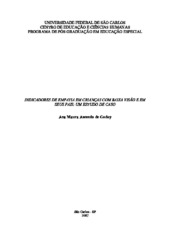| dc.contributor.author | Godoy, Ana Maura Azevedo de | |
| dc.date.accessioned | 2016-06-02T19:45:57Z | |
| dc.date.available | 2007-11-22 | |
| dc.date.available | 2016-06-02T19:45:57Z | |
| dc.date.issued | 2007-02-07 | |
| dc.identifier.citation | GODOY, Ana Maura Azevedo de. Empathiy indicators in children with low eyesight and their parents: a case study.. 2007. 125 f. Dissertação (Mestrado em Ciências Humanas) - Universidade Federal de São Carlos, São Carlos, 2007. | por |
| dc.identifier.uri | https://repositorio.ufscar.br/handle/ufscar/2968 | |
| dc.description.abstract | Empathy is important in the maintenance interpersonal relationships, and cam be
considered a behavior protective factor for behavior problem. This work is aimed at
describing and evaluating empathy in two sisters with low eyesight, one of them is nine
and the other one is 11 years old and of their parents, in a attempt to: 1. identify
subclasses of empathical abilities present in the repertoire of the children; 2.
characterize similarities and differences in the frequency of children s empathy
subclasses; 3. evaluate the father s and mother s level of empathy; 4. characterize
similarities and differences between the father s and mother s educational actions. The
instruments utilized were: a structured interview script with the parents, empathy
inventory (EI), stories that were printed and recorded in audio and semi-structured
interviews with the children. The parents answered both the interview individually,
which was recorded, and the empathy inventory (EI) with the researcher s help. With
the children, the researcher developed three activities which were filmed: present
printed stories, stories in audio and interview the children in an attempt to investigate
the recognition of the situation and the emotions of the characters in a specific situation.
Data obtained from the interviewed parents and the children were analyzed
qualitatively, and the (EI) provided quantitative results. Results indicate that parents
present a high frequency of overprotective behavior, intercalated with granted
autonomies in domestic activities and in requests made by the children. The father s
report was different from the mother´s, who answers may be a result of her beliefs about
the development of her daughters. The (EI) showed that the mother is more empathic
than the father. With regard the results obtained with the children, they suggest that they
present behaviors that are indicative of empathy, and that they also identify and understand the emotions of joy, sorrow, fear and disgust presented by the characters of the stories. | eng |
| dc.description.sponsorship | Financiadora de Estudos e Projetos | |
| dc.format | application/pdf | por |
| dc.language | por | por |
| dc.publisher | Universidade Federal de São Carlos | por |
| dc.rights | Acesso Aberto | por |
| dc.subject | Educação especial | por |
| dc.subject | Habilidades sociais | por |
| dc.subject | Empatia | por |
| dc.subject | Expressão | por |
| dc.subject | Emoções | por |
| dc.subject | Deficiência visual | por |
| dc.subject | Special education | eng |
| dc.subject | Social skills | eng |
| dc.subject | Empathy | eng |
| dc.subject | Feeling expression | eng |
| dc.subject | Visual impairment | eng |
| dc.title | Indicadores de empatia em crianças com baixa visão e em seus pais : um estudo de caso | por |
| dc.title.alternative | Empathiy indicators in children with low eyesight and their parents: a case study | eng |
| dc.type | Dissertação | por |
| dc.contributor.advisor1 | Del Prette, Almir | |
| dc.contributor.advisor1Lattes | http://lattes.cnpq.br/2191226494887247 | por |
| dc.description.resumo | A empatia é importante para manutenção dos relacionamentos interpessoais podendo ser considerada um fator de proteção de problema de comportamento. O objetivo deste trabalho foi descrever e avaliar a empatia de duas irmãs com baixa visão, uma com nove e outra com 11 anos e de seus pais, procurando: 1. identificar as
subclasses de habilidades empáticas presentes no repertório das crianças; 2. caracterizar
semelhanças e diferenças de freqüência das subclasses de empatia das crianças; 3.
avaliar a empatia do pai e da mãe e 4. caracterizar semelhanças e diferenças nas ações
educativas do pai e da mãe. Os instrumentos utilizados foram: roteiro de entrevista
semi-estruturada com os pais, inventário de empatia (IE), histórias impressas e gravadas
em áudio e entrevista semi-estruturada com as crianças. Os pais responderam a entrevista individualmente a qual foi gravada e o inventário de empatia (IE) com ajuda da pesquisadora. Com as crianças a pesquisadora desenvolveu três atividades que foram filmadas: apresentar histórias impressas, apresentar histórias em áudio e entrevistar as crianças investigando o reconhecimento das situações e das emoções dos personagens em situações específicas. Os dados da entrevista obtidos com os pais e os obtidos com as crianças foram analisados qualitativamente, já com IE obtiveram-se resultados quantitativos. O resultado indicou que os pais apresentam uma alta freqüência de
comportamentos de superproteção intercalados com autonomias concedidas em atividades domésticas e em solicitações feitas pelas próprias crianças. O conteúdo dos relatos do pai apresentou-se diferente em relação ao da mãe, podendo esta ter respondido sob controle das crenças que tem sobre o desenvolvimento das filhas. O IE mostrou que a mãe é mais empática que o pai. Com relação aos resultados obtidos com as crianças, estes sugerem que elas apresentam comportamentos que são indicativos de empatia, além de identificar e compreender as emoções de alegria, tristeza, medo e nojo
apresentados pelos personagens das histórias. | por |
| dc.publisher.country | BR | por |
| dc.publisher.initials | UFSCar | por |
| dc.publisher.program | Programa de Pós-Graduação em Educação Especial - PPGEEs | por |
| dc.subject.cnpq | CIENCIAS HUMANAS::EDUCACAO::TOPICOS ESPECIFICOS DE EDUCACAO::EDUCACAO ESPECIAL | por |
| dc.contributor.authorlattes | http://lattes.cnpq.br/1775145947210502 | por |
